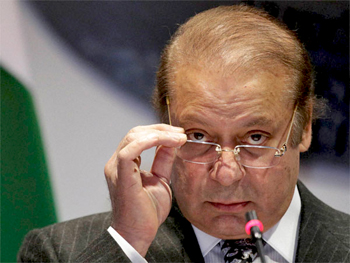Beijing, May 14: Pakistan Prime Minister Nawaz Sharif today said that the multi-billion dollar CPEC was an economic project open to all nations in the region and it "must not be politicised", taking pot-shots at India for boycotting China's high-profile Belt and Road Forum.
 India skipped the meeting due to its concerns over the China-Pakistan Economic Corridor (CPEC), which goes through Pakistan-occupied Kashmir (PoK). However, few Indian scholars attended the opening session of the two-day "Belt and Road" conference here that brought together leaders from 29 nations.
India skipped the meeting due to its concerns over the China-Pakistan Economic Corridor (CPEC), which goes through Pakistan-occupied Kashmir (PoK). However, few Indian scholars attended the opening session of the two-day "Belt and Road" conference here that brought together leaders from 29 nations.
"Let me make it very clear that CPEC is an economic undertaking open to all countries in the region. It has no geographical boundaries. It must not be politicised," Sharif said in his speech at the inaugural session of the forum, defending the project over which India has raised objections.
Stating that CPEC has emerged as core and flagship project of China's One Belt and One Road (OBOR), he said, "OBOR signifies that geo-economics must take precedence over geo-politics and that the centre of gravity should shift from conflict to cooperation. We see it as a path for overcoming terrorism and extremism."
In implementing CPEC "we are not striving to merely leverage geography for economic prosperity, we are also trying to build peaceful, connected and caring neighbourhood," he told the gathering.
"It is time we transcend our differences, resolve conflicts through diplomacy and leave legacy of peace for future generations," Sharif said without directly referring to India.
Sharif, who is leading a large delegation and clinched more Chinese finance for six more projects of the CPEC, said "the fact is that OBOR belongs to all of us, those who are participating in it and those who are not as yet. OBOR has truly become a global community."
"As OBOR unfolds across continents we see it fostering inclusion, creating tolerance and promoting acceptance of cultural diversity," he said.
He said Pakistan believes that the most powerful impact of OBOR will be on the lives of poor and marginalised people who would have higher incomes, better education and health facilities. It would help eradicating poverty, he added.
"The CPEC is core project of OBOR. In fact it has been rightly called its flagship because it aims to connect neighbourhoods of East and West Asia. CPEC makes Pakistan both a conduit, destination for cross regional investment and trade," he said.
Terming China as Pakistan's "close friend and trusted ally", he said his participation at the forum was to celebrate the remarkable success of the seminal initiative of OBOR.
He also said that infrastructure, energy and industrial projects under CPEC are moving as envisaged.
Many of them would be completed before their timelines. Unprecedented economic social and cultural benefits will accrue from the CPEC not just for people of Pakistan but also the people of the entire region, he said.
"Through a resolute will and sound planning as well as steadfast support of our Chinese friends, we shaped an enabling environment for CPEC to take off," he said.
He said CPEC is also producing new entrepreneurs and creating new jobs and attracting international investment.
Playing down differences over the project among different provinces in his country, Sharif said, "the CPEC is owned and nurtured by all citizens of Pakistan. It is also fully compatible with our own vision 2025 which invests our own resources in multiple corridors of regional cooperation including energy, industry trade and transportation."





Comments
Add new comment